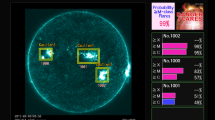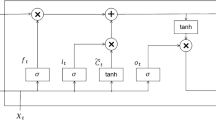Abstract
The research on solar flare predicting holds significant practical and scientific value for safeguarding human activities. Current solar flare prediction models have not fully considered important factors such as time step length, nor have they conducted a comparative analysis of the physical features in multiple models or explored the consistency in the importance of features. In this work, based on SHARP data from SDO, we build 9 machine learning-based solar flare prediction models for binary “Yes” or “No” class prediction within the next 24 hours, and study the impact of different time steps and other factors on the forecasting performance. The main results are as follows. (1) The predictive performance of eight deep learning models shows an increasing trend as the time step length increases, and the models perform the best at the length of 40. (2) In predicting solar flares of ≥C class and ≥M class, the True Skill Statistic(TSS) of deep learning models consistently outperforms that of baseline model. For the same model, the TSS for predicting ≥M class flares generally exceeds that for predicting ≥C class flares. (3) The Brier Skill Score (BSS) of deep learning models significantly surpasses that of baseline model in predicting ≥C class flares. However, the BSS scores of the nine models are comparable for predicting ≥M class flares. For the same model, the BSS for predicting ≥C class flares is generally higher than that for predicting ≥M class flares. (4) Through feature importance analysis of multiple models, the common features that consistently rank at the top and bottom are identified.







Similar content being viewed by others
Data Availability
No datasets were generated or analysed during the current study.
References
Abhale, A.B., Avulapalli, J.R.: Enhancing intrusion detection recursive feature elimination with resampling in wsn. Int. J. Syst. Assur. Eng. Manag. 14, 2642–2660 (2023). https://doi.org/10.1007/s13198-023-02128-3
Abraham, S., Aniyan, A., Kembhavi, A.K., Philip, N., Vaghmare, K.: Detection of bars in galaxies using a deep convolutional neural network. Mon. Not. R. Astron. Soc. 477(1), 894–903 (2018). https://doi.org/10.1093/mnras/sty627
Ahmadzadeh, A., Aydin, B., Georgoulis, M.K., Kempton, D.J., Mahajan, S.S., Angryk, R.A.: How to train your flare prediction model: revisiting robust sampling of rare events. Astrophys. J. Suppl. Ser. 43, Article ID 23 (2021). https://doi.org/10.3847/1538-4365/abec88
Akioka, M., Nagatsuma, T., Miyake, W., Ohtaka, K., Marubashi, K.: The L5 mission for space weather forecasting. Adv. Space Res. 35, 65–69 (2004). Retrieved from https://www.sciencedirect.com/science/article/abs/pii/S0273117704008713
Asaly, S., Gottlieb, L.-A., Reuveni, Y.: Using support vector machine (svm) and ionospheric total electron content (tec) data for solar flare predictions. IEEE J. Sel. Top. Appl. Earth Obs. Remote Sens. 14, 1469–1481 (2020). ieeexplore.ieee.org/document/9292938
Baker, D., Daly, E., Daglis, I., Kappenman, J.G., Panasyuk, M.: Effects of space weather on technology infrastructure. Wiley Online Library (2004). agupubs.onlinelibrary.wiley.com/doi/full/10.1029/2003SW000044
Bobra, M.G., Ioannidis, S.: Predicting coronal mass ejections using machine learning methods. Astrophys. J. 821(127), 1–7 (2016). https://doi.org/10.3847/0004-637X/821/2/127
Brier, G.W., et al.: Verification of forecasts expressed in terms of probability. Mon. Weather Rev. 78(1), 1–3 (1950). journals.ametsoc.org/view/journals/mwre/78/1/1520-0493_1950_078_0001_vofeit_2_0_co_2.xml
Chen, A., Ye, Q., Wang, J.: Flare index prediction with machine learning algorithms. Sol. Phys. 296(10), 150 (2021). link.springer.com/article/10.1007/s11207-021-01895-1.
Cinar, Y.G., Mirisaee, H., Goswami, P., Gaussier, E., Aït-Bachir, A.: Period-aware content attention rnns for time series forecasting with missing values. Neurocomputing 312, 177–186 (2018). https://doi.org/10.1016/j.neucom.2018.05.0903
Deng, Z., Wang, F., Deng, H., Tan, L., Deng, L., Feng, S.: Fine-grained solar flare forecasting based on the hybrid convolutional neural networks. Astrophys. J. 922(2), 232 (2021). ui.adsabs.harvard.edu/abs/2021ApJ...922..232D/abstract
Deshmukh, V., Baskar, S., Bradley, E., Berger, T., Meiss, J.D.: Machine learning approaches to solar-flare forecasting: Is complex better? (2022). ArXiv preprint. arXiv:2202.08776
Florios, K., Kontogiannis, I., Park, S.-H., Guerra, J.A., Benvenuto, F., Bloomfield, D.S., Georgoulis, M.K.: Forecasting solar flares using magnetogram-based predictors and machine learning. Sol. Phys. 293(2), 28 (2017). https://doi.org/10.1007/s11207-018-1250-41
Guastavino, S., Marchetti, F., Benvenuto, F., Campi, C., Piana, M.: Implementation paradigm for supervised flare forecasting studies: a deep learning application with video data. Astron. Astrophys. 662, A105 (2022). arXiv:2110.12554
Hanssen, A.W., Kuipers, W.J.A.: (1965). Meded. Verh. 81(2)
Heidke, P.: Berechnung des erfolges und der güte der windstärkevorhersagen im sturmwarnungsdienst. Geogr. Ann. 8(4), 301–349 (1926). https://doi.org/10.1080/20014422.1926.11881138
Huang, X., Zhang, L., Wang, H., Li, L.: Improving the performance of solar flare prediction using active longitudes information. Astron. Astrophys. 549, A127 (2013). https://doi.org/10.1051/0004-6361/201219742
Inceoglu, F., Jeppesen, J.H., Kongstad, P., Marcano, N.J.H., Jacobsen, R.H., Karoff, C.: Using machine learning methods to forecast if solar flares will be associated with cmes and seps. Astrophys. J. 861(2), 128 (2018). arXiv:1806.07117
Ioffe, S., Szegedy, C.: Batch Normalization: Accelerating Deep Network Training by Reducing Internal Covariate Shift (2015). ArXiv preprint. arXiv:1502.03167. https://doi.org/10.48550/arXiv.1502.03167
Jiao, Z., Sun, H., Wang, X., Manchester, W., Gombosi, T., Hero, A., Chen, Y.: Solar flare intensity prediction with machine learning models. Space Weather 18(7), e2020SW002440 (2020). https://doi.org/10.1029/2020SW002440
Levine, R.A., Wilks, D.S.: Statistical methods in the atmospheric sciences. J. Am. Stat. Assoc. 95(449), 344–344 (2000). https://doi.org/10.2307/2669579
Li, X., Zheng, Y., Wang, X., Wang, L.: Predicting solar flares using a novel deep convolutional neural network. Astrophys. J. 891(1), 10 (2020). https://doi.org/10.3847/1538-4357/ab6d04/meta
Liu, H., Liu, C., Wang, J.T., Wang, H.: Predicting coronal mass ejections using sdo/hmi vector magnetic data products and recurrent neural networks. Astrophys. J. 890(1), 12 (2017). https://doi.org/10.3847/1538-4357/ab6850
Liu, H., Liu, C., Wang, J.T., Wang, H.: Predicting solar flares using a long short-term memory network. Astrophys. J. 877(2), 121 (2019). https://doi.org/10.3847/1538-4357/ab1b3c
Lu, L., Yu, Q.-L., Wang, D., Lu, Q.: ENA Coding Aperture Imager for STEM Mission at L5. pp. 231–234 (2022). https://doi.org/10.1007/978-3-030-72896-0_51
Luong, M.-T., Pham, H., Manning, C.D.: Effective approaches to attention-based neural machine translation (2015). ArXiv preprint. arXiv:1508.04025. aclanthology.org/D15-1166/
Muneeb, M.: Lstm input timestep optimization using simulated annealing for wind power predictions. PLoS ONE 17(10), e0275649 (2022). https://doi.org/10.1371/journal.pone.0275649
Pesnell, W.D., Thompson, B., Chamberlin, P., et al.: Sol. Phys. 275, 3. (2012). https://doi.org/10.1007/s11207-011-9841-3
Priest, E., Forbes, T.: The magnetic nature of solar flares. Astron. Astrophys. Rev. 10(4), 313–377 (2002). https://doi.org/10.1007/s001590100013
Schou, J., Scherrer, P.H., Bush, R.I., Wachter, R., Couvidat, S.E., Rabello-Soares, M.C., et al.: Design and ground calibration of the helioseismic and magnetic imager (hmi) instrument on the solar dynamics observatory (sdo). Sol. Phys. 275, 229–259 (2012). https://doi.org/10.1007/s11207-011-9842-2
Schrijver, C.J.: A characteristic magnetic field pattern associated with all major solar flares and its use in flare forecasting. Astrophys. J. 655, L117–L120 (2007). https://doi.org/10.1086/511857
Vech, D., Stevens, M.L., Paulson, K.W., Malaspina, D.M., Case, A.W., Klein, K.G., Kasper, J.C.: A powerful machine learning technique to extract proton core, beam, and \(\alpha \)-particle parameters from velocity distribution functions in space plasmas. Astron. Astrophys. 650, A198 (2021). ui.adsabs.harvard.edu/abs/2021A%26A...650A.198V/abstract
Wan, J., Fu, J.-F., Liu, J.-F., Shi, J.-K., Jin, C.-G., Zhang, H.-P.: Class imbalance problem in short-term solar flare prediction. Res. Astron. Astrophys. 21(9), 237 (2021). https://doi.org/10.1088/1674-4527/21/9/237
Wang, Y., Zhang, X., Lu, M., Wang, H., Choe, Y.: Attention augmentation with multi-residual in bidirectional lstm. Neurocomputing 385, 340–347 (2020). https://doi.org/10.1016/j.neucom.2019.10.068
Welsch, B.T., Li, Y., Schuck, P.W., Fisher, G.J.: What is the relationship between photospheric flow fields and solar flares? Astrophys. J. 705, 821–843 (2009) https://doi.org/10.1088/0004-637X/705/1/821
Wilks, D.S.: Sampling distributions of the Brier score and Brier skill score under serial dependence. Q. J. R. Meteorol. Soc. 136(653), 2109–2118 (2010). https://doi.org/10.1002/qj.709
Yang, S.-H., Huang, J.-W., Huang, C.-J., Chiu, P.-H., Lai, H.-Y., Chen, Y.-Y.: Selection of essential neural activity timesteps for intracortical brain–computer interface based on recurrent neural network. Sensors 21(19), 6372 (2021). pubmed.ncbi.nlm.nih.gov/34640699/
Yu, D., Huang, X., Hu, Q., Zhou, R., Wang, H., Cui, Y.: Short-term solar flare prediction using multiresolution predictors. Astrophys. J. 709(1), 321 (2009). https://doi.org/10.1088/0004-637x/709/1/321
Zheng, Y., Li, X., Wang, X.: Solar flare prediction with the hybrid deep convolutional neural network. Astrophys. J. 885(1), 73 (2019). https://doi.org/10.3847/1538-4357
Zheng, Y., Li, X., Yan, S., Huang, X., Lou, H., Li, Z.: Multiclass solar flare forecasting models with different deep learning algorithms. Mon. Not. R. Astron. Soc. 521, 5384–5399 (2023a). https://doi.org/10.1093/mnras/stad839
Zheng, Y., Qin, W., Li, X., Ling, Y., Huang, X., Li, X., Lou, H.: Comparative analysis of machine learning models for solar flare prediction. Astrophys. Space Sci. 368, 2642–2660 (2023b). https://doi.org/10.1007/s10509-023-04209-y
Zhu, G., Lin, G., Wang, D., Yang, X.: A new approach for the regression of the center coordinates and radius of the solar disk using a deep convolutional neural network. Astrophys. J. 902(1), 72 (2020). https://doi.org/10.3847/1538-4357/abb2a0
Acknowledgements
We express our gratitude to the anonymous reviewers whose insights and feedback have greatly enhanced the quality of this paper. Our acknowledgments also extend to the dedicated members of the SDO/HMI team for their contributions to the SDO mission.
Funding
This research received funding from the National Natural Science Foundation of China (Grants No. 11703009 and No. 11803010), the Natural Science Foundation of Jiangsu Province, China (Grants No. BK20170566 and No. BK20201199), National Natural Science Astronomy Joint Fund (No. U2031133), the Kunming Foreign (International) Cooperation Base Project (No. GHJD-2021022), and was supported by the Qing Lan Project.
Author information
Authors and Affiliations
Contributions
Jinfang Wei, Yanfang Zheng, and Xuebao Li wrote the main manuscript text. Changtian Xiang, Pengchao Yan, Xusheng Huang, Liang Dong and Hengrui Lou prepared tables and figures. Shuainan Yan, Hongwei Ye, Xuefeng Li, Shunhuang Zhang, Yexin Pan and Huiwen Wu participated in the manuscript writing and revision. Yanfang Zheng supervised the project.All authors reviewed the manuscript.
Corresponding authors
Ethics declarations
Competing interests
The authors declare no competing interests.
Additional information
Publisher’s Note
Springer Nature remains neutral with regard to jurisdictional claims in published maps and institutional affiliations.
Rights and permissions
Springer Nature or its licensor (e.g. a society or other partner) holds exclusive rights to this article under a publishing agreement with the author(s) or other rightsholder(s); author self-archiving of the accepted manuscript version of this article is solely governed by the terms of such publishing agreement and applicable law.
About this article
Cite this article
Wei, J., Zheng, Y., Li, X. et al. The influence of magnetic field parameters and time step on deep learning models of solar flare prediction. Astrophys Space Sci 369, 48 (2024). https://doi.org/10.1007/s10509-024-04314-6
Received:
Accepted:
Published:
DOI: https://doi.org/10.1007/s10509-024-04314-6




